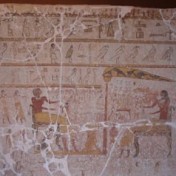Following the pioneering work of the Egyptian archaeologist Ahmed Fakhry in the 70s , the Western Oases of Egypt have been investigated regularly since then by several missions. From 1977 onwards, the French Institute of Oriental Archaeology (IFAO) is excavating near the modern village of Balat, in Dakhla Oasis. Situated 200 km W of the Nile Valley, the Dakhla Oasis was home to a vibrant urbanized community dating from the 6th Pharaonic Dynasty (2350-2150) and boasting a series of local rulers – known today by a group of monumental mastaba tombs, a palatial building serving as an administrative center and other monuments. Last week, in the premices of the Egyptian Cultural Center in Athens, Laure Pantalacci, former director of the IFAO presented the work done in this remoted yet full of pharaonic remains site and explained the links of centre and periphery in Pharaonic Egypt.
Living on the Fringe: The Western Oases of Egypt 4000 years ago
16 May 2011
by Archaeology Newsroom
- A
- A
- A



